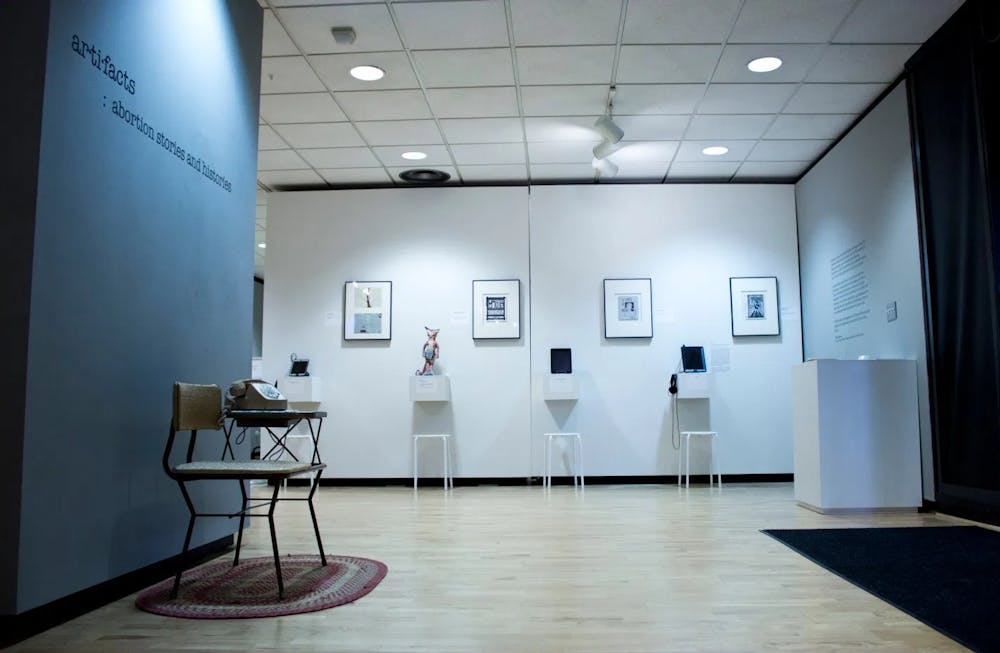Debates surrounding reproductive rights have been prominent in politics since the mid-20th century. The insensitivity of such debates, however, often drowns out the stories of people who have firsthand experiences with abortion. How long have such stories been silenced? And what can we learn from them today?
This semester, the Center for Documentary Studies will be displaying “Ar·ti·facts: Abortion Stories and Histories,” a traveling multi-media exhibition that reveals untold abortion experiences in order to address common misconceptions regarding reproductive rights and health.
“Ar·ti·facts” was created by Melissa Madera and is based on her podcast “The Abortion Diary.” The Center for Documentary Studies’ exhibitions director, Courtney Reid-Eaton, and her intern, Amber Delgado, organized the display of “Ar·ti·facts” on campus.
“I found each piece of art, each interview to be extremely helpful in learning about abortion experiences and the purpose of this exhibit,” Delgado explained. “We wanted to allow women to share their stories about abortion in a way that doesn’t shame them.”
The exhibit features a series of playlists from Madera’s “The Abortion Diary,” allowing listeners to explore various perspectives surrounding the history of abortion. One playlist titled “Pre-Roe Stories,” for example, displays the physical dangers and restricted information regarding abortion prior to the landmark Roe v. Wade decision in 1973.
“When I found out I was pregnant, I didn’t think it was possible,” one podcast interviewee described. “I didn’t know who to talk to. Who do you share with? You look for other women. I discovered that other women had similar issues, but everyone was very coy about sharing what they knew.”
Before the Roe decision, many women turned to underground services that resisted the law for the benefit of women’s safety. The exhibit features a piece dedicated to one such service, the Abortion Counseling Service of the Chicago Women’s Liberation Union (commonly known as “Jane”). Jane provided thousands of illegal abortions for women from 1969 to 1973, and “Ar·ti·facts” reveals the reasons why.
The lack of information and silenced discussions about reproductive rights have impacted women of every generation in every region of the world. One of the exhibit’s playlists titled “Abortion Around The World” shows how the struggles surrounding abortion are not exclusive to the U.S., as women from England to Colombia to Canada and beyond share their powerful stories.
“Ar·ti·facts” is impressive not only for its extensive and complex subject matter, but for its emphasis on the art of telling unheard stories. The stories featured in the exhibit cannot be found in traditional history textbooks or newspaper headlines. These stories provide a greater perspective on the emotional and spiritual impacts of abortion.
“I realized I needed to tell my own story and listen to the stories of others,” Madera said in an audio piece included in the exhibit. “It was the singular most isolating experience of my life. It was also the most impactful. I would have never guessed that my experience would create the Abortion Diary.”
Throughout the exhibit, there are several pieces of art and media that focus less on the often divisive science and politics of abortion, and more on the legal struggles and emotional isolation of people with abortion experiences. Many interviewees of “The Abortion Diary” suggest that these experiences are inevitably overwhelmed with grief and isolation. This exhibit, however, demonstrates how pain can be transformed through creative outlets. Zines, letters, comic books and pamphlets discussing reproductive rights are displayed on the walls, each illustrating the vast range of thoughts and emotions involved with abortion.
The “Rites and Rituals” playlist shows how women cope with their grief by honoring spirits and commemorating their abortion experiences; some plant trees, some pray, but all find ways of respecting their experiences.
Although the exhibit focuses on stories of women in the past, it nonetheless invites all visitors to share their own experiences. An empty drywall panel, push pins and blank sheets of paper ask each observer to engage with the exhibit by providing their stories and opinions.
By listening to others’ experiences and reflecting on our own, we can better learn about the intricacies regarding sensitive political and personal topics. “Ar·ti·facts” exemplifies the importance of sharing and understanding unheard histories, as their silence prevents change in policies, behaviors and narratives.
“Ar·ti·facts: Abortion Stories and Histories” is located in the Juanita Kreps Gallery in the Center for Documentary Studies. It is on display until May 30.
Get The Chronicle straight to your inbox
Sign up for our weekly newsletter. Cancel at any time.

